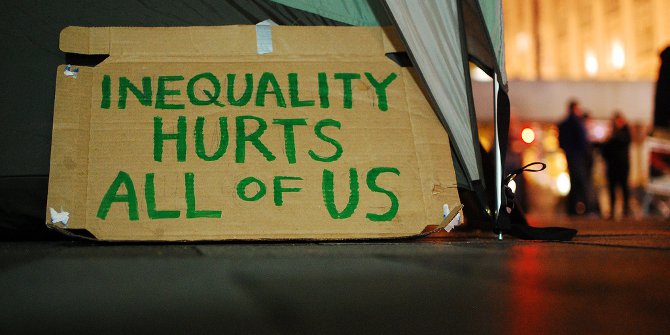 In new research, Carl Dement looks at how prisons and jails can be better integrated into state and local emergency management planning to protect the health and safety of inmates during disasters. Using the hurricane and wildfire season of 2020-21 as a case study, interviews with correctional and emergency management professionals show that emergency managers need to take a more comprehensive and collaborative approach which considers the needs of prisons and jails. This approach should include risk assessments, clear communication plans, comprehensive inmate evacuation plans, adequate staffing and resources, disaster training for correctional professionals, and post-disaster recovery plans.
In new research, Carl Dement looks at how prisons and jails can be better integrated into state and local emergency management planning to protect the health and safety of inmates during disasters. Using the hurricane and wildfire season of 2020-21 as a case study, interviews with correctional and emergency management professionals show that emergency managers need to take a more comprehensive and collaborative approach which considers the needs of prisons and jails. This approach should include risk assessments, clear communication plans, comprehensive inmate evacuation plans, adequate staffing and resources, disaster training for correctional professionals, and post-disaster recovery plans.
Correctional facilities – prisons and jails – have unique needs and challenges during disasters, and failure to adequately prepare for emergencies can have serious consequences for both inmates and staff. It is important to include these facilities in broader emergency management planning to fulfill the government’s legal and ethical duty to protect the health and safety of inmates during disasters. My new comparative analysis of the response to hurricanes Katrina and Maria by correctional facilities in the US has shed light on these challenges and the need for effective emergency management planning.
Studying how emergency managers work with Offices of Emergency Management
The US hurricane and wildfire season of 2020-2021 provided an opportunity to study the extent of collaboration between local Offices of Emergency Management (OEM) – local and state agencies responsible for planning for and responding to disasters – and the correctional facilities within their jurisdiction. The recurring nature of these regional disasters should make mitigation, preparation, response, and recovery easier to plan for.
Interviews with 41 state and county correctional and emergency management (EM) professionals – those whose job it is to prepare for and respond to disasters when they occur – directly involved in these disasters revealed poor responses which were caused by a lack of integration of OEMs into correctional disaster preparedness. Neither party saw the OEM as having a role here. This is understandable for correctional administrators because disaster operations are not their core function. The function of the OEM, however, is to include all elements of the community in disaster planning.
Emergency managers could play a critical role in helping correctional facilities prepare for disasters. Indeed, EM professionals are required to engage members of the whole community in disaster preparedness. To effectively prepare correctional facilities, emergency managers should take a comprehensive and collaborative approach that considers the unique challenges and needs of correctional institutions. Greater integration of the OEM in correctional disaster planning will yield several benefits. Once implemented, these adjustments will move local and state governments toward better safeguards for the public and the inmates they have a duty to care for.
How emergency managers can work better with correctional facilities
First, the onus is on the local OEM to initiate a relationship with their correctional counterparts to improve disaster preparedness. A Threat and Hazard Identification and Risk Assessment (THIRA) begins this process by identifying risks and people or property vulnerable to them. Although this assessment is an essential first step in understanding who and what is most at risk, EM interviewees in rural jurisdictions had not completed one although they face seasonal hazards routinely. They were aware of the existence of these assessments, how important they are to disaster planning, and did intend to do them at some point.
Second, emergency managers should work with correctional facility staff to develop clear communication plans and protocols. This includes establishing interoperability between facility staff and outside agencies, including the courts, as well as developing methods for facilitating communication between inmates and their families during and after a disaster.

“230208-A-PA223-002” (CC BY 2.0) by LouisvilleUSACE
Third, emergency managers should help correctional facilities develop comprehensive evacuation plans for meeting the unique needs of inmates. Many have disabilities, serious medical conditions, or special security concerns. Planning also includes identifying suitable shelter locations, transportation options, and ensuring all necessary supplies and equipment are available. Equipment shortfalls during a forced corrections evacuation include hard restraints like handcuffs and chains. Additionally, barcode technology should be adopted for inmate evacuations akin to what is used by the public. Many jail management systems (JMS) cannot communicate with other facilities, even within the same state. A common barcode system could mitigate this limitation thereby improving accountability of inmates.
Fourth, emergency managers should work with correctional facilities to ensure adequate staffing levels and resources are available to respond to emergencies. This includes providing training and education for staff on disaster response and recovery, as well as ensuring that necessary supplies and equipment are stockpiled and regularly maintained. One best practice uncovered during my research was the use of “Hurricane Packets” for correctional staff. These are formal plans created by staff when they are hired for how they will take care of their own families and property prior to disaster so they can make it to work. Another key tool to correctional administration during disasters is WebEOC (Web Emergency Operations Center). This software was developed by Juvare and is the de facto national asset management system but is virtually unknown to the correctional world. As a result, resources available to jails and prisons are not utilized by them.
Fifth, emergency managers should invite correctional professionals to participate in community disaster training and exercises. This is not currently being done. One sheriff’s office in this sample did occasionally send a representative to disaster exercises, but only to function as embarkation security or traffic control. This deputy was not from the jail and did not voice any concerns on the jail’s behalf or speak to any disaster planning done by the jail.
Finally, emergency managers should collaborate with correctional facilities to develop post-disaster recovery plans that address the long-term needs of both staff and inmates. This includes providing access to mental health services, addressing physical damage to facilities, and ensuring correctional administrators have access to necessary resources and support as they transition back to regular operations.
The important role of emergency managers
Emergency managers should play a critical role in helping correctional facilities prepare for disasters by taking a comprehensive, inclusive, and collaborative approach that addresses the unique needs and challenges faced by these institutions. By working closely with correctional staff, emergency managers can help ensure these facilities are prepared to respond effectively to emergencies and safeguard the health and safety of staff, inmates, and the public.
- This article is based on the paper, ‘Public administration in disasters: Integrating emergency management into jail and prison preparedness’, in Public Administration Review.
- Please read our comments policy before commenting.
- Note: This article gives the views of the author, and not the position of USAPP – American Politics and Policy, nor the London School of Economics.
- Shortened URL for this post: https://bit.ly/3UTrGHT






